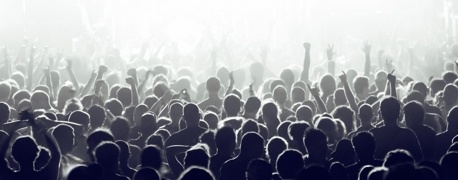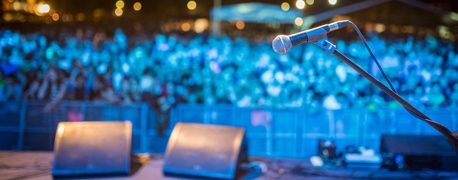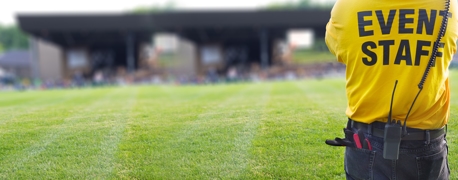Crowd Surges: Why They Happen

It was just after 9 p.m. at NRG Park in Houston, Texas. 50,000 people were in attendance at the Astroworld Festival, and rapper Travis Scott had just taken the stage. The crowd had a life of its own, surging and pressing toward the stage. But then, the energy turned frantic. People were passing out. People were being trampled. People were dying.
8 people lost their lives that night in Houston. Another, a 22-year-old college student, passed away several days later from her injuries. A 9-year-old boy who fell from his father's shoulders and was trampled by the crowd succumbed to his injuries about a week after being placed in a medically induced coma. Hundreds more were injured.
Unfortunately, that is just one example of a crowd surge that turned deadly. Why do these keep happening, and why are they so dangerous? Let’s find out.
Understanding Crowd Surges
A “surge” can be defined as a sudden and powerful movement like one would witness with waves or the ocean tide.
The people trapped in a crowd surge will experience unrelenting pressure from all sides. The pressure often increases gradually, and by the time they realize they’re in danger, it’s too late. There is no way to escape. They may get squeezed so hard that they can’t even draw a breath. If anyone falls to the ground, there will be no room for them to get up. Pileups can happen, and that leaves anyone underneath at risk of asphyxiation and crush injuries.
A crowd surge can be described as drowning, but not in water. It’s a crushing drowning – in a sea of people.
Why Crowd Surges & Crowd Crush Happen
Crowd surges and crowd crush happen in places where too many people are crowded in one place. They can happen at the gates of a venue, where a lot of people are funneled into too small of an entrance or exit, or they can happen in standing room environments: venues where people stand to watch a show or event. There is little chance of a crowd surge or crowd crush in areas of a venue where people have assigned seats.
Deadly crowd surges typically have two key components:
- Dense Crowd. Density is a main part of what makes a crowd surge deadly. When a lot of people are packed into a small place, they will not have enough room to move or even breathe. A small motion can have a ripple effect and will magnify in force until it crushes people in the epicenter or on the edges if they are pressed against an immovable object like a barrier or wall.
- Catalyst. The second part of a crowd surge is a catalyst: something that causes the crowd to shift or move. Sudden rain, more people flowing into an already crowded area, or even a move forward to a stage when a performance starts can all cause a deadly surge. A commotion like a fight or a weapon in a crowd can have the same effect.
You can clearly see the crowd surging in this video of a 2005 Oasis concert in Manchester, England. It looks like a wave, moving from the right to the left of the screen. You can see some people fall and try to get back up.
Preventing Crowd Crush
Crowd surges and crowd crush are preventable, even at large events with tens of thousands of people in attendance. It’s about managing and separating the crowd so it does not become too dense. That’s what should have happened at Astroworld and every other event where people were injured or died from crowd crush.
Organizers and performers share responsibility for protecting fans:
- They need to manage crowds at entrances and exits, using enough security personnel and barriers that can withstand large crowds. Adding more points of entry can help dilute crowds as they come into or leave a venue. This is important to avoid trampling and other injuries at entrances and exits, and to avoid allowing ticketless attendees inside (another potential source of overcrowding).
- They need to use barriers and pens to separate crowds. Crowd separation is crucial in preventing surges and crowd crush. Venues should be organized in such a way as to prevent too many people from converging in one place, and sectioning off standing-room-only areas can help with this. Barriers between sections should be strong enough and high enough to withstand normal crowd pressure, and there should be walkways in between to allow security and emergency personnel to access different areas of the crowd. Security personnel should be vigilant in preventing each section from becoming too crowded.
- There need to be enough security officers to manage the event. At the 2021 Astroworld Festival, there were 1,283 security officers for a crowd of 50,000. They were overwhelmed at entrances earlier in the day, and they were overwhelmed again when Travis Scott took the stage at around 9 p.m. The combination of overcrowding, lack of crowd separation, and not enough security officers had deadly consequences.
- Crowd spotters should be posted around the perimeter of the crowd, high enough that they can spot surges or crush points. When a situation is identified, the spotter should be able to alert the performer. The performer should then pause the show until the situation is under control. The power and influence of a performer at a large venue cannot be overstated. They can bring attention to the problem, tell everyone to calm down, and help security and emergency personnel do their jobs.
Injuries & Deaths Caused by Crowd Crush
Most of the deaths caused by crowd surges are not due to trampling. They are caused by asphyxiation – people getting squeezed so hard that they can’t breathe. Although a taller or larger person may have a slightly better chance of surviving, in the end, size won’t make a significant difference. Even the biggest and strongest person can be crushed by a large crowd.
That’s what happened to a Wal-Mart employee the day after Thanksgiving in 2008 in Valley Stream, Long Island. The store was offering significant Black Friday discounts, and by 2 a.m. over 1,000 people were already waiting outside. By 5 a.m., the crowd had grown to about 2,000 people, and shoppers had jumped the barrier and were crowded at the front entrance. People were getting frantic, shouting, “Push the doors in!”
The store only had one security guard on-site at the time, so the asset protection manager instructed several of his largest employees, most of whom worked in the stockroom, to man the sides of the sliding glass door entrance to help anyone who fell as the crowd flooded in. One of these employees was 6’5” and weighed about 480 pounds. Unfortunately, his size couldn’t save him from the events that followed.
The sliding doors at the front of the Wal-Mart eventually burst from their frames, and the crowd started to surge inside. The 6’5” stockroom employee was hit by one of the sliding glass doors and fell. He never got back up. The coroner’s report did not mention any bruises, broken bones, or internal injuries. The man had suffocated.
Injured in a Crowd Surge? You Deserve Answers & Justice.
When crowd surges happen, there’s always a reason. Poor crowd management, inadequate security, and outright negligence cause the circumstances that lead to crowd surges and crowd crush. Survivors and victims’ families deserve answers, and they deserve justice.
At Arnold & Itkin, we are committed to helping people from all walks of life who have suffered serious harm because of the carelessness and wrongdoing of others. When concert organizers, performers, and venues care more about selling tickets than protecting fans, our concert injury lawyers are prepared to stand up and fight for what’s right. We are determined to hold at-fault parties accountable. No matter what.


